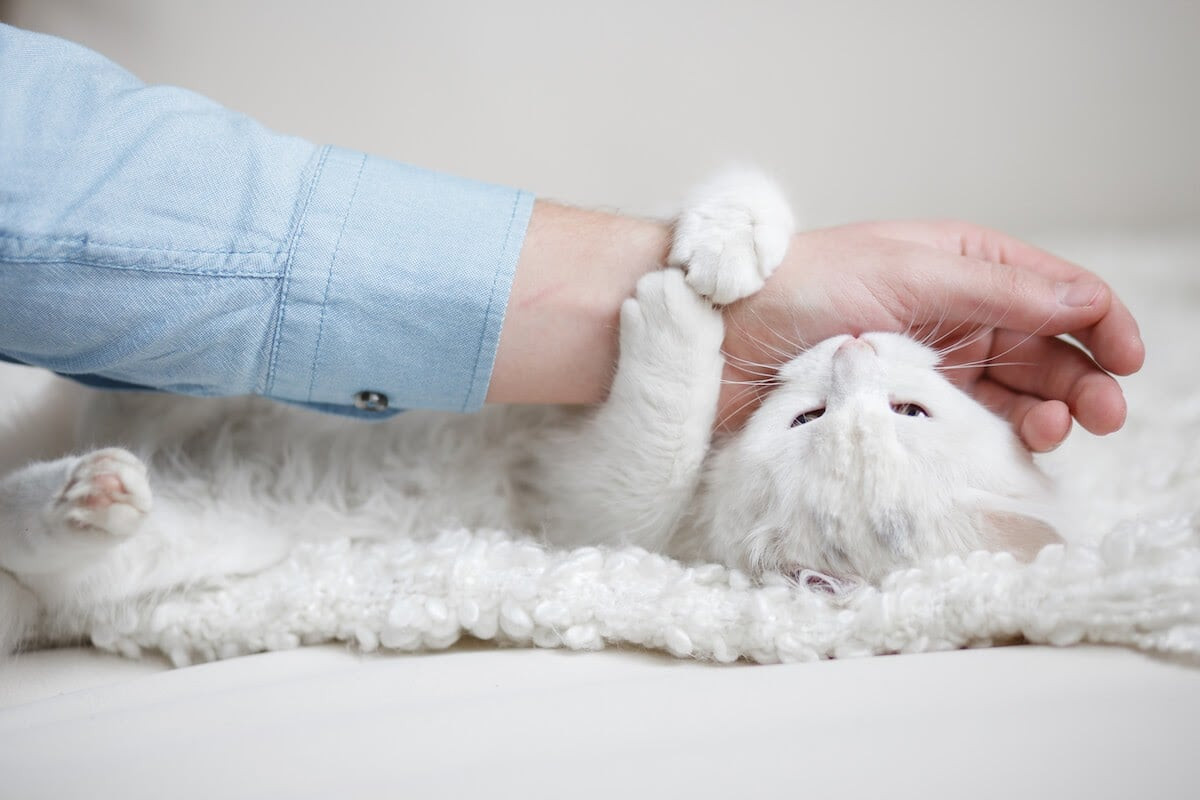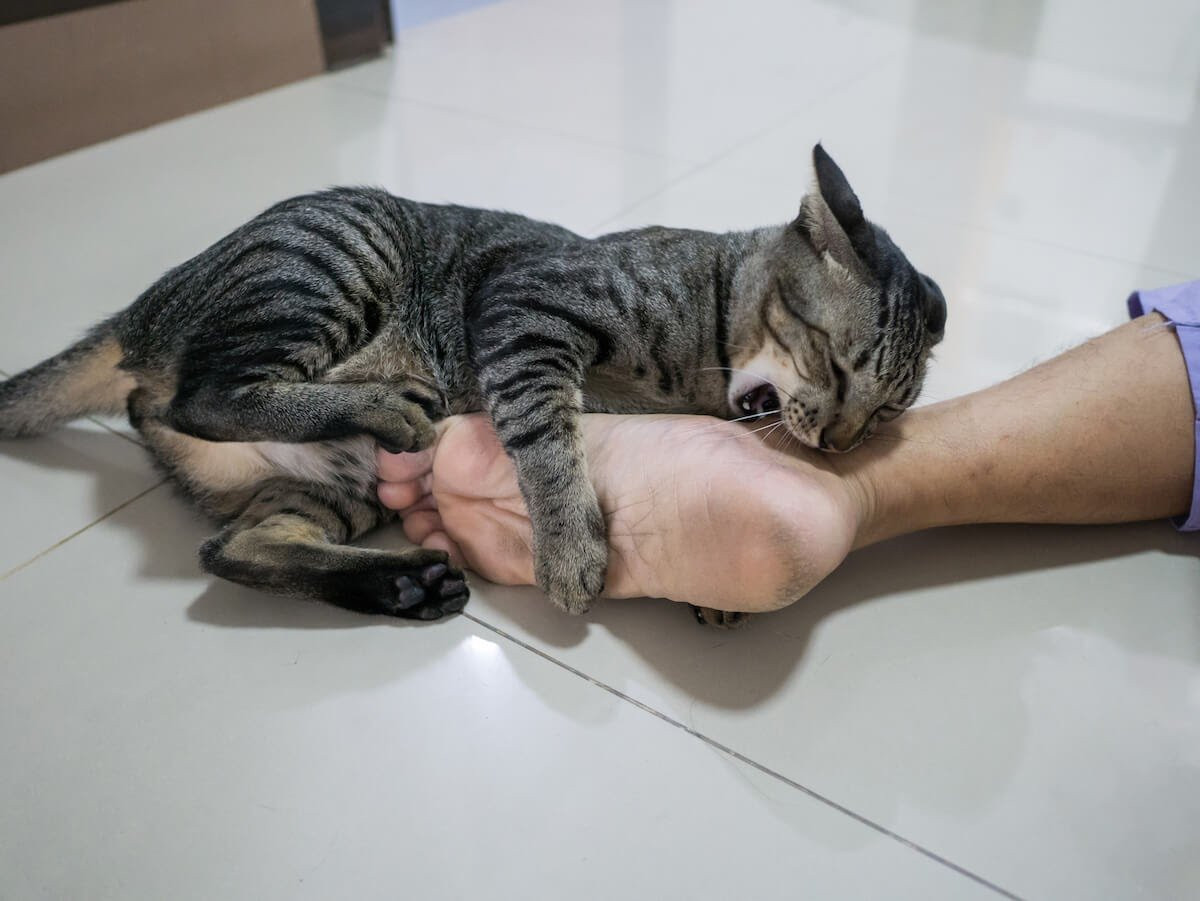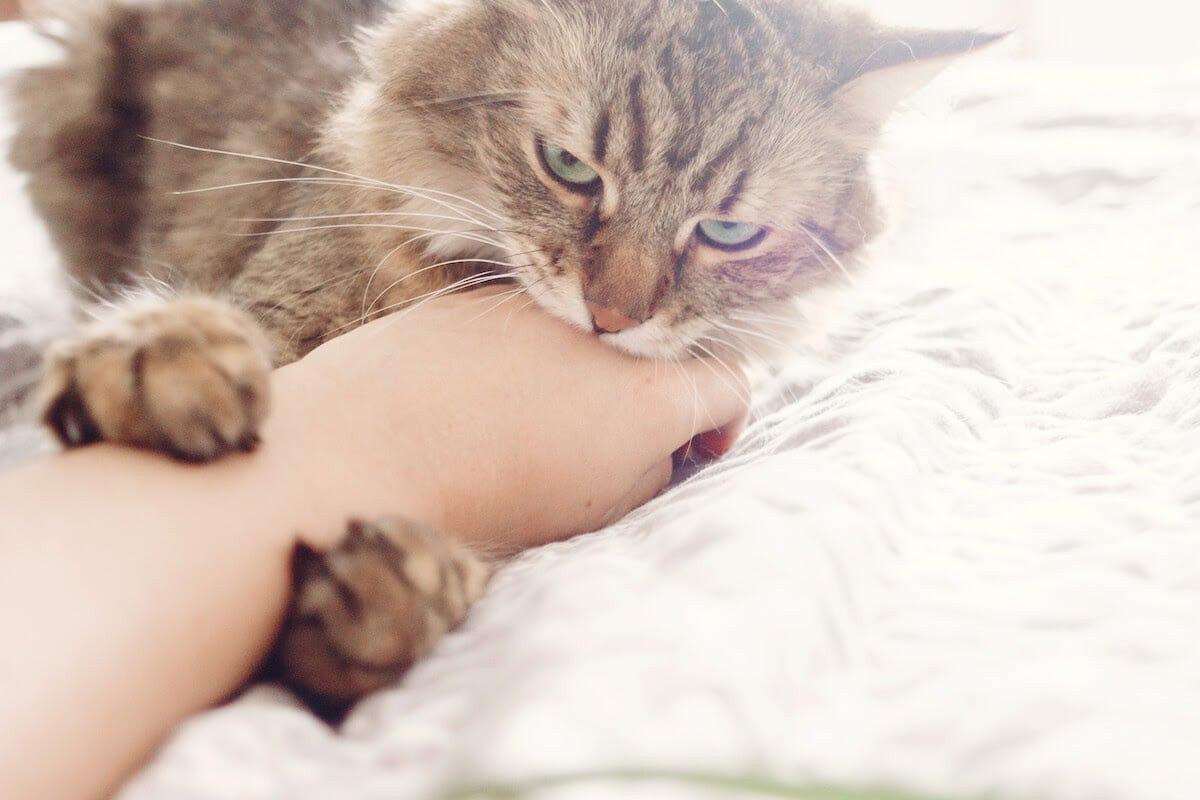Are you perplexed when your usually affectionate cat, purring contentedly on your lap, suddenly turns and nips you? This behavior, often called a “love bite” or petting-induced aggression, is more common than you might think. At solcat.net, we’ll delve into the reasons behind this feline quirk, helping you understand your cat’s signals and strengthen your bond. Understanding these behaviors and creating a harmonious environment are key to a happy cat-human relationship, and we’ll explore preventative measures to help foster that bond.
1. What Does It Mean When a Cat Bites While Purring?
Your cat biting while purring often indicates overstimulation or mixed signals. Cats have a limit to how much petting they enjoy, and purring doesn’t always equal happiness. It can also express anxiety or conflicting emotions. According to Dr. Leslie A. Lyons from the University of Missouri’s Feline Genetics Research, cats use purring for various reasons, not just contentment.
- Overstimulation: Repetitive stroking can become overwhelming for some cats, leading to a sudden bite as a way to say, “Enough.”
- Static Electricity: Some believe that stroking can create static electricity on a cat’s fur, causing discomfort and prompting a bite.
- Underlying Pain: An older cat might have a painful joint that you inadvertently touch while petting, causing a defensive bite.
 Content cat being pet
Content cat being pet
2. What Are the Different Types of Cat Bites?
Understanding the type of bite can help you determine the cause and how to respond. Cat bites range from playful nips to aggressive attacks, each with its unique trigger. According to the American Animal Hospital Association (AAHA), recognizing these differences is crucial for maintaining a safe and positive relationship with your feline companion.
| Type of Bite | Description | Possible Cause |
|---|---|---|
| Playful Bite | Gentle nips, often during play, that don’t break the skin. | Normal kitten behavior, mimicking hunting. |
| Love Bite | Soft, gentle bites during petting, usually accompanied by purring. | Overstimulation, mixed signals, or a cat’s way of showing affection. |
| Defensive Bite | Quick, sharp bites when a cat feels threatened, scared, or in pain. | Fear, pain, territoriality, or feeling trapped. |
| Redirected Bite | Aggression directed at a nearby person or animal when a cat is aroused by something else (e.g., seeing another cat). | Frustration, territoriality, or inability to reach the original target of their aggression. |
| Predatory Bite | Bites during hunting behavior, usually aimed at small animals or toys. | Instinctual behavior, triggered by movement and prey-like characteristics. |
3. How Can I Tell If My Cat Is About to Bite?
Recognizing the warning signs is key to preventing bites. Cats communicate through body language, and learning to read these signals can help you avoid unwanted nips. Veterinarian Dr. Sarah Wooten emphasizes the importance of observing a cat’s posture, tail movements, and ear position to understand their emotional state.
- Tail Twitching: A rapidly twitching tail often indicates irritation or agitation.
- Flattened Ears: Ears held flat against the head signal fear or aggression.
- Dilated Pupils: Enlarged pupils can indicate excitement, fear, or pain.
- Tense Body: A stiff or tense posture suggests discomfort or anxiety.
- Vocalization: Growling, hissing, or yowling are clear warnings to back off.
 Angry cat showing warning signs
Angry cat showing warning signs
4. What Medical Conditions Can Cause a Cat to Bite?
Certain medical conditions can cause a cat to become more irritable and prone to biting. Painful conditions like arthritis or dental disease can make a cat more sensitive to touch. According to the Cornell Feline Health Center, underlying health issues should always be ruled out when a cat’s behavior changes suddenly.
- Arthritis: Joint pain can make a cat reluctant to be touched, especially in certain areas.
- Dental Disease: Mouth pain can cause irritability and defensive biting.
- Hyperthyroidism: This hormonal imbalance can cause increased irritability and aggression.
- Neurological Issues: In rare cases, brain tumors or other neurological problems can affect a cat’s behavior.
- Skin Conditions: Irritated or painful skin can make a cat sensitive to touch.
5. How Can I Prevent Petting-Induced Aggression?
Preventing petting-induced aggression involves understanding your cat’s preferences and respecting their boundaries. Pay attention to their body language and adjust your petting style accordingly. Feline behaviorist Pam Johnson-Bennett recommends shorter petting sessions and focusing on areas cats enjoy being touched.
- Shorten Petting Sessions: Keep petting sessions brief and end them before your cat becomes overstimulated.
- Focus on Preferred Areas: Most cats enjoy being petted on the head, cheeks, and under the chin.
- Avoid Sensitive Areas: Avoid petting the belly, tail, or back, as these areas are often sensitive.
- Pay Attention to Body Language: Watch for signs of discomfort, such as tail twitching or flattened ears.
- Let Your Cat Initiate: Allow your cat to approach you for petting rather than forcing interaction.
- Positive Reinforcement: Reward calm behavior with treats and praise.
6. What Should I Do If My Cat Bites Me?
If your cat bites you, it’s essential to react calmly and avoid punishing them. Punishing your cat can create fear and anxiety, making the behavior worse. The Humane Society recommends washing the wound thoroughly with soap and water and seeking medical attention if necessary.
- Wash the Wound: Clean the bite thoroughly with soap and water.
- Apply Antiseptic: Use an antiseptic to prevent infection.
- Seek Medical Attention: Consult a doctor if the bite is deep, bleeding heavily, or shows signs of infection.
- Avoid Punishing Your Cat: Punishing your cat will only create fear and worsen the problem.
- Identify the Trigger: Try to understand what caused the bite so you can avoid it in the future.
7. How Does Socialization Affect Biting Behavior in Cats?
Early socialization plays a crucial role in shaping a cat’s behavior and reducing the likelihood of aggression. Kittens who are exposed to positive human interaction from a young age are more likely to be comfortable with being handled. According to research from the University of California, Davis, kittens should be handled gently and frequently during their first few weeks of life to promote socialization.
- Early Handling: Handle kittens gently and frequently from a young age.
- Positive Experiences: Expose kittens to a variety of people, environments, and sounds.
- Avoid Force: Never force a kitten into a situation that makes them uncomfortable.
- Mother Cat’s Influence: A calm and socialized mother cat can positively influence her kittens’ behavior.
- Continue Socialization: Continue socialization throughout the cat’s life to maintain their comfort level.
8. What Role Does Environment Play in Cat Biting?
A cat’s environment can significantly impact their behavior, including their tendency to bite. A stressful or unstable environment can increase a cat’s anxiety and trigger defensive behaviors. According to the International Cat Association (TICA), providing a safe and enriching environment is essential for a cat’s well-being.
- Safe Space: Ensure your cat has a safe and quiet place to retreat to when they feel overwhelmed.
- Enrichment: Provide toys, scratching posts, and climbing structures to keep your cat mentally and physically stimulated.
- Reduce Stress: Minimize loud noises, sudden changes, and other stressors in the environment.
- Multiple Cat Households: Ensure each cat has their own resources (food, water, litter box) to reduce competition and aggression.
- Feliway Diffusers: Consider using a Feliway diffuser to release calming pheromones into the environment.
 Scared cat hiding under a bed
Scared cat hiding under a bed
9. How Can I Encourage Positive Interactions With My Cat?
Building a strong bond with your cat requires patience, understanding, and positive reinforcement. Creating positive associations with human interaction can help reduce biting and promote affection. Cat behavior consultant Jackson Galaxy emphasizes the importance of understanding a cat’s natural instincts and providing outlets for their energy.
- Playtime: Engage in regular playtime with your cat using interactive toys.
- Positive Reinforcement: Reward calm and affectionate behavior with treats, praise, and petting.
- Respect Boundaries: Respect your cat’s boundaries and avoid forcing interaction.
- Create a Routine: Establish a consistent routine for feeding, playtime, and rest.
- Observe Body Language: Pay attention to your cat’s body language and respond accordingly.
10. When Should I Consult a Veterinarian or Behaviorist About My Cat’s Biting?
If your cat’s biting is frequent, severe, or accompanied by other behavioral changes, it’s essential to seek professional help. A veterinarian can rule out underlying medical conditions, and a behaviorist can help you address any behavioral issues. The American Veterinary Medical Association (AVMA) recommends consulting a veterinarian for any sudden or unexplained changes in behavior.
- Frequent Biting: If your cat bites you regularly, it’s time to seek professional help.
- Severe Bites: Bites that break the skin or cause significant pain should be evaluated by a doctor and a veterinarian.
- Behavioral Changes: If your cat’s biting is accompanied by other changes in behavior, such as increased aggression or withdrawal, consult a professional.
- Unexplained Biting: If you can’t identify the trigger for your cat’s biting, seek professional guidance.
- Failed Attempts: If you’ve tried to address the biting behavior on your own without success, it’s time to consult a veterinarian or behaviorist.
11. Understanding Purring and Its Connection to Biting
Purring is often associated with contentment, but it can also indicate stress, pain, or self-soothing. Understanding the context of your cat’s purring can provide clues to why they might be biting. Dr. Elizabeth von Muggenthaler, a bioacoustician, has studied the healing properties of purrs, but also notes they can be a sign of distress.
- Contentment: A relaxed cat, lying down with half-closed eyes, is likely purring out of contentment.
- Self-Soothing: A cat purring in a stressful situation, such as at the vet, may be using it to calm themselves.
- Pain Relief: Cats may purr when injured or in pain, as the vibrations can have a therapeutic effect.
- Mixed Signals: Sometimes, a cat may purr and bite simultaneously, indicating conflicting emotions.
12. The Role of Genetics in Cat Aggression
Genetics can play a role in a cat’s temperament and predisposition to aggression. Some breeds are known to be more territorial or assertive than others. Research from the Journal of Veterinary Behavior suggests that genetics, combined with environmental factors, can influence a cat’s behavior.
- Breed Predisposition: Some breeds, like Bengals or Siamese, may be more prone to aggression.
- Temperament: A cat’s inherent temperament can influence their reaction to stimuli.
- Early Experiences: Genetics interact with early experiences to shape a cat’s behavior.
- Selective Breeding: Responsible breeders prioritize temperament when selecting breeding cats.
- Adoption Considerations: Consider a cat’s breed and history when adopting a new pet.
13. How to Create a Cat-Friendly Home
Creating a cat-friendly home can significantly reduce stress and prevent biting behaviors. Providing resources, enrichment, and a safe environment are essential for a happy and well-adjusted cat. The American Association of Feline Practitioners (AAFP) offers guidelines for creating a cat-friendly environment.
- Multiple Resources: Provide multiple food and water bowls, litter boxes, scratching posts, and beds.
- Vertical Space: Cats love to climb and observe from high places. Provide shelves, cat trees, and window perches.
- Safe Hiding Spots: Ensure your cat has access to safe hiding spots where they can retreat when feeling overwhelmed.
- Playtime: Engage in regular playtime with your cat to provide mental and physical stimulation.
- Territorial Marking: Allow your cat to mark their territory by rubbing against furniture and scratching posts.
14. The Impact of Diet on Cat Behavior
A cat’s diet can influence their behavior, including their tendency to bite. Nutritional deficiencies or food sensitivities can contribute to irritability and aggression. Veterinarian Dr. Lisa Pierson emphasizes the importance of feeding cats a high-quality, species-appropriate diet.
- Protein: Ensure your cat’s diet is high in protein, as cats are obligate carnivores.
- Grain-Free: Avoid foods with excessive grains or fillers, as these can cause digestive issues and behavioral problems.
- Hydration: Encourage your cat to drink plenty of water to prevent dehydration, which can lead to irritability.
- Food Sensitivities: Be aware of potential food sensitivities or allergies that could be causing skin irritation and biting.
- Consult a Vet: Consult with your veterinarian about the best diet for your cat’s individual needs.
15. Latest Research on Cat Biting Behavior (2024 Update)
Recent studies have shed new light on the complexities of cat biting behavior. Research published in the Journal of Feline Medicine and Surgery in June 2024 highlights the role of the gut microbiome in influencing feline behavior, including aggression.
| Research Area | Findings | Implications |
|---|---|---|
| Gut Microbiome | Imbalances in gut bacteria can affect mood and behavior in cats. | Probiotics and dietary changes may help manage aggression. |
| Feline Facial Expressions | Researchers have identified a wider range of feline facial expressions than previously thought, aiding in better understanding of cat emotions. | Improved ability to interpret cat body language and prevent bites. |
| Environmental Enrichment | Studies continue to emphasize the importance of environmental enrichment in reducing stress and aggression in cats. | Providing stimulating toys, climbing structures, and hiding places can improve cat well-being. |
FAQ About Why Cats Bite While Purring
- Why does my cat purr and then bite me? Your cat may be overstimulated, experiencing conflicting emotions, or trying to communicate discomfort.
- Is it normal for cats to bite while purring? It’s not uncommon, but it’s important to understand the underlying cause.
- How can I stop my cat from biting me when I pet them? Shorten petting sessions, focus on preferred areas, and pay attention to body language.
- What does a “love bite” mean? A gentle nip during petting may be a sign of affection or overstimulation.
- Should I be worried if my cat bites me while purring? It depends on the severity and frequency of the biting. Consult a vet or behaviorist if you’re concerned.
- Can medical conditions cause a cat to bite while purring? Yes, pain or discomfort from underlying health issues can contribute to biting.
- How does early socialization affect biting behavior? Kittens who are well-socialized are less likely to exhibit aggressive behaviors.
- What role does environment play in cat biting? A stressful or unstable environment can increase anxiety and trigger defensive biting.
- How can I create a cat-friendly home? Provide resources, enrichment, and a safe environment to reduce stress.
- What kind of diet can affect cat biting? Protein deficiencies can cause bad behaviour
Conclusion: Building a Stronger Bond with Your Feline Friend
Understanding why cats bite while purring requires careful observation, empathy, and a willingness to learn your cat’s individual preferences. By recognizing the signs of overstimulation, respecting their boundaries, and providing a safe and enriching environment, you can strengthen your bond with your feline companion and prevent unwanted nips. Remember, solcat.net is here to provide you with reliable information and resources to help you navigate the wonderful world of cat ownership.
For more insights into feline behavior and expert tips on cat care, visit solcat.net today. Join our community of cat lovers in the USA and discover a wealth of articles, images, videos, and helpful resources. Got questions? Reach out to us at our Seattle location: 950 Alaskan Way, Seattle, WA 98104, United States, or call us at +1 (206) 386-4000. Let solcat.net be your trusted guide in creating a happy and harmonious life with your beloved cat.
